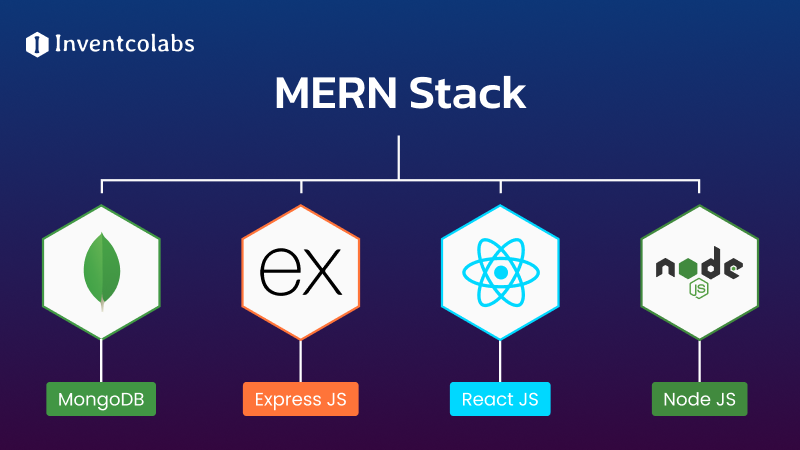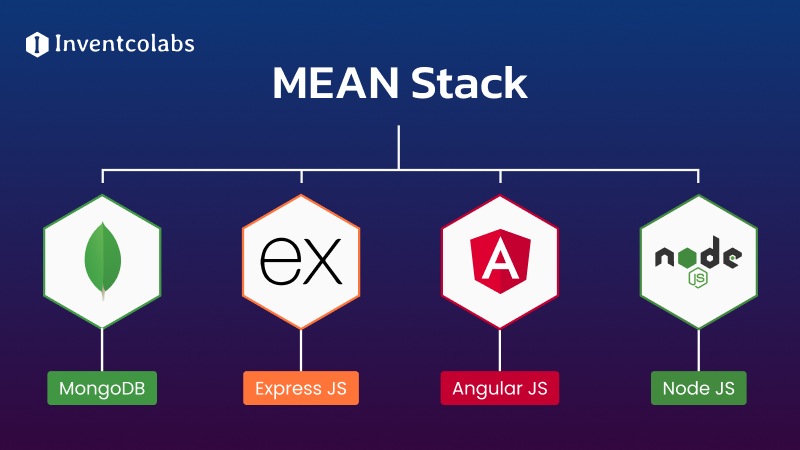The world of web development is constantly changing. The way you go about selecting the right stack largely determines the success of your project. With numerous selections to choose from, it’s easy to become uncertain as to what will fit your needs the best. At this point, we’ll focus on the two most common stacks – MERN stack vs MEAN stack- and provide the information necessary for you to make the ideal decision around selecting the right stack in 2025. Experienced or a first-timer – read ahead to learn more about the differences between MEAN and MERN stacks and what benefits they provide for your projects.
Introduction
We will examine the two JavaScript-based web development stacks in more detail in this article and help you understand the difference between the MEAN stack and MERN stack and decide which one is best suited to your project. In MERN, MongoDB, Express, React, and Node.js are used whereas in MEAN, MongoDB, Express, AngularJS, and Node.js are used for development. Custom web development company uses MERN and MEAN stack to develop web applications.
What is MERN Stack?

Confused between MEAN vs MERN? We are here to help. Let’s first delve into understanding the MERN stack. There are four components in the MERN stack: MongoDB, Express.js, React.js, and Node.js. MEAN stacks, however, use AngularJS instead of ReactJS.
MongoDB offers a NoSQL database to store application data, alongside Express.js which is a web application framework that supplies an easy-to-use API. ReactJS is a library designed for creating user interfaces and Node.js is a JavaScript runtime environment that enables the execution of JavaScript outside of the browser. All in all, these four technologies give developers the means to construct comprehensive web applications using JavaScript.
Benefits of MERN Stack
The MERN stack provides a wealth of benefits when it comes to web development and MERN stack development company. Thanks to using just one language, developers can quickly code client and server-side applications. React is likewise very effective in creating appealing user interfaces, due to its fast-paced and scalable nature; this makes it excellent for larger projects. In comparison to the MEAN stack vs MERN stack, the MERN stack offers a host of advantages when it comes to web development. With only one language needed for coding client and server-side applications, the process is expedited.
What’s more, React – renowned for its scalability and speed – provides excellent user interfaces even on larger projects. Open sourcing increases its value further by giving developers access to an expansive network of experienced coders. When you need a rapid solution, the MERN stack shines. With its parts working in tandem, applications are ready for deployment in no time at all. Its prominence makes finding experienced professionals with knowledge of the technology far easier than with lesser-known options.
How Does MERN Stack Work?
If you are anguished about choosing between a MERN or MEAN stack, it is best to first analyze their individual benefits and operational styles. MERN Stack is a full stack JavaScript framework for creating web applications and websites. It integrates four open source technologies, MongoDB, Express.js, ReactJS, and Node.js, to offer a complete development solution through MERN stack development services.
MongoDB stores data in JSON format, Express adds features like routing and middleware support, React is a library for constructing user interfaces, and Node provides the ability to use JavaScript on the server side. The benefit of using MERN Stack is that it enables full stack development with one programming language which boosts speed and productivity without any licensing fees incurred from its utilization.
The MERN stack is a framework that everyone needs to develop web applications. Developers can use a single language to create web applications in full stack. And this makes the development process faster. Moreover, it is free to use, so people can use this to try web applications.
Explore More: Why Next.JS is the Technology to Lookout in the Future?
What is MEAN Stack?

There are considerable differences that exist when it comes to MERN vs MEAN stack. MEAN Stack is a fast-growing open source platform for creating intricate web apps. It leverages a collection of JavaScript frameworks, including MongoDB, Express.JS, Angular, and Node.JS, that work together to produce both mobile and web applications. AngularJS is a JavaScript framework that increases HTML’s features to develop dynamic web applications on multiple platforms like Windows, Linux, and Unix.
Node.js facilitates coding server-side apps with JavaScript in addition to having non-blocking I/O operations. MongoDB is an open source NoSQL database which stores information in JSON format as well as handles massive amounts of data. In addition, Express.JS is an application framework for Node.js responsible for navigation, requests, and app views.
Benefits of MEAN Stack
In the fight between choosing a MEAN or MERN stack, it is better to first take into account their individual benefits. Using a MEAN Stack for web development presents many advantages. Not only is it an excellent way to learn and utilize JavaScript for both front and back-end development, but its versatility is also great for constructing diverse web apps. Furthermore, its reliability and scalability make it a perfect fit for expansive projects. Plus, developers have access to various tools and libraries that simplify the web development process significantly.
Aside from that, the MEAN Stack development services are open source, so they can be used for free and modified to suit the needs of different projects. This is an excellent choice if you cannot build your own custom framework or development stack on a tight budget. HTML5, CSS3, and JavaScript are also supported.
How Does Mean Stack Works?
If you are thinking of choosing between the MEAN vs MERN stack, it is better to understand how they work. MEAN Stack is a platform based on JavaScript that consists of MongoDB, Express.js, AngularJS, and Node.js as its primary languages providing an end-to-end solution for developing a database, web server, and front-end web application. The powerful MongoDB document-oriented database stores data in JSON format with easy scalability and great performance while Express.js is a lightweight web framework to handle middleware functions and routes HTTP requests.
With AngularJS you can create single-page applications using JavaScript and Node.js is a cross-platform runtime environment to run JavaScript code on a server making MEAN Stack an ideal choice for full-stack web development by allowing quick and simple deployment of full-stack applications with robust high-performance capabilities.
The MEAN stack makes it easy to rapidly develop and deploy web applications. It is lightweight, flexible, and provides a great way for developers to quickly get started with web development. The components are also highly compatible with each other, making it easy to integrate different technologies into your projects.
Differences Between MERN Stack and MEAN Stack
It’s likely you’ve heard of the MERN stack and the MEAN stack, but what’s the difference between them? Let’s examine the MERN stack vs MEAN stack. MERN and MEAN stacks differ in the following ways:
- When it comes to the difference between MERN and MEAN stack, the MERN stack uses MongoDB whereas the MEAN stack uses MySQL. MongoDB is a NoSQL database whereas MySQL is a relational database. In MongoDB, data is stored in JSON-like documents whereas in MySQL, it is stored in tables.
- One of the main differences between MERN and MEAN is that the MERN stack utilizes Express to build web applications, while the MEAN stack relies on AngularJS. Express is a minimalistic piece of software and provides routing and middleware solutions. On the other hand, AngularJS is feature-rich and suitable for producing single-page web applications. React is used in the MERN stack, and AngularJS in the MEAN stack – both have distinct syntaxes and ways of creating user interfaces. React uses JSX and AngularJS primarily works with HTML templates.
- JavaScript is used for both MEAN stack and MERN stack. However, the MERN stack also uses Node.js whereas the MEAN stack does not. A server-side JavaScript application can be written using Node.js, an open-source, cross-platform runtime environment. As opposed to the MEAN stack, which needs a Node.js web server such as Heroku or Amazon Web Services (AWS), the MERN stack can be deployed on any web server.
|
MEAN stack |
MERN stack |
|
|
Components |
MongoDB,Express.js, AngularJS, Node.js |
MongoDB,Express.js, React.js, Node.js |
|
Front-end |
AngularJS |
React.js |
|
Back-end |
Node.js, Express.js |
Node.js, Express.js |
|
Database |
MongoDB |
MongoDB |
|
Architectural |
MVC |
MERN |
|
Data flow |
Two-way binding |
One-way binding |
|
SEO friendly |
Not very SEO |
SEO friendly |
|
Learning curve |
Steep |
Moderate |
|
Popularity |
Medium |
High |
|
Performance |
Good |
Average |
|
Scalability |
Limited |
Extended |
Despite their differences, the MERN stack and the MEAN stack are both popular development stacks. Ultimately, it’s up to you to decide which stack is best for your project. Each stack has its own advantages and disadvantages depending on the project requirements.
Explore More: Flutter Vs. React Native – Detailed Framework Comparison
Similarities Between MERN Stack and MEAN Stack
MERN stack vs MEAN stack shares several key similarities:
- JavaScript is the programming language used by both stacks.
- The databases used by both stacks are MongoDB.
- The web server platform for both stacks is Node.js.
- The web application framework in both stacks is Express.js.
- For front-end development, both stacks use React or Angular.
- The stacks are both open source and free to use.
- Package management is handled by NPM in both stacks.
There are many similarities between MEAN and MERN stacks, such as: they both run on JavaScript, feature MongoDB as their database, and use Node.js for the web server platform. Additionally, both these frameworks are open source and free to use and modify. The most noteworthy characteristic is that they are both full-stack JavaScript solutions, encompassing everything for building a web application from the front-end UI to the back-end database and server logic.
Another one of the similarities between MERN and MEAN is that both use MongoDB as their database solution. MongoDB is a powerful document-oriented database that is well-suited to storing JSON data. As a result, both MERN and MEAN Stack data can be accessed in a consistent manner.
Both MERN and MEAN Stack applications can be deployed to popular cloud hosting platforms such as Amazon Web Services (AWS) and Heroku. This makes it easy to get started with either stack without having to worry about setting up your own infrastructure.
Explore More: Salesforce Vs AWS: What To Choose For Your Business?
Things to know When Choosing the Right Stack in 2025
When choosing the right stack for your project in 2025, keep these factors in mind:
- When deciding the programming language to use, Python may be a good choice if you want something more powerful and flexible, but JavaScript is an easy option with plenty of community support.
- MongoDB is one common database for JavaScript projects however MySQL and PostgreSQL can also be utilized with both languages.
- Popular frameworks for JavaScript are React and Angular while Django and Flask are often used with Python. Select the most applicable framework that works best with your project knowing the positives and negatives of each.
- There are multiple hosting platforms to choose from such as AWS, Heroku, or DigitalOcean; select the one that suits your project while taking into account pricing models and features.
- In addition to development tools, testing libraries, and utility libraries, each language may require different tools and libraries, depending on your project’s requirements.
- Finally, you should stay up to date with the latest technology trends. Some technologies may be popular now and may not be in the future. So, learning technologies and keeping you up to date will bring you more opportunities. And this makes us take informed decisions too when choosing the stack for projects.
Final Thoughts
With our comparison of the two stacks, we hope that we have helped you understand the basic difference and applications of the two technologies. A professional MEAN stack development company can streamline your operations Whereas if you find yourself lost you always hire MERN stack developers to help you through the process. The stacks are both powerful combinations of tools that can help you create amazing applications. To make an informed decision about which stack will be best for your project, consider the features and benefits each stack brings to your project based on the abovementioned comparison points.
FAQs
Q. Which Stack will be in high demand in 2025?
Ans. In 2025 and beyond, the MERN stack is expected to remain in high demand. With the flexibility and scalability it offers, it is increasingly becoming popular among developers because it uses powerful frameworks MongoDB, Express, React, and Node.js, for developing dynamic web applications. Moreover, it is also an integral part of custom mobile app development services.
Q. What future does the MEAN stack hold?
Ans. A dynamic website can be created using MEAN stack that includes these four technologies – MongoDB, Express, Angular, and Node.js. For future technologies it will prove to be a powerful tool. It will be efficient and powerful in looking at how it is allowing to scale and adapt to futuristic development choices.
Q. What is the best choice of full-stack in the coming times?
Ans. When it comes to the best choice of stacks, MEAN and MERN are always in high demand. The decision of choosing the stack is completely based on your team’s needs. Moreover, one can hire dedicated web developers in order to make a more informed decision.
Q. What are the prominent limitations of MERN stack?
Ans.The most noticeable limitation of the MERN stack is the difficulty in managing projects that is reported by MERN stack developers. Ensuring that the stack works correctly and that the technologies are integrated properly can be challenging.
Q. What are all the main differences between full-stack and MERN stack?
Ans.MERN stack and full stack may seem the same but it’s actually different. Full stack is a range of technologies to build web applications. While MERN is the combination of four main technologies – MongoDB, Express, Angular, and ReactJS. Each has its own challenges. To gain an in-depth knowledge of the differences existing between the two stacks one can hire dedicated Laravel developers.






